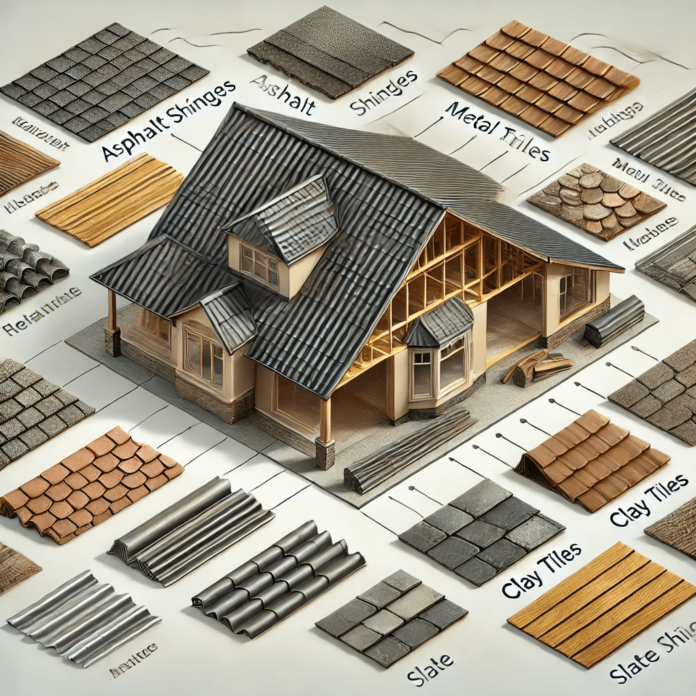Introduction
Choosing the right material for your roof is a critical decision for any homeowner. A thorough comparison of roofing materials helps ensure you select the best option for your budget, climate, and long-term needs. Whether you’re considering asphalt shingles, metal roofing, or eco-friendly options like green roofing, understanding the pros and cons of each material is essential. Let’s explore a detailed comparison of roofing materials to help you make the most informed decision for your home.
Roofing Materials Comparison: Understanding the Best Options

When deciding on the right material for your roof, a detailed roofing materials comparison is essential. Each type of roofing material offers unique benefits and drawbacks, depending on your home’s needs, climate, and budget. For example, asphalt shingles are affordable and easy to install, making them a popular choice. However, metal roofing stands out for its durability and long lifespan, ideal for homes in extreme weather conditions. Other options, like clay tiles or slate, offer unmatched longevity but come at a higher price and installation complexity. Evaluating these factors will help you choose the best material for your roof.
Asphalt Shingles
Pros of Asphalt Shingles
Asphalt shingles are one of the most commonly used roofing materials, thanks to their affordability and availability. They are easy to install, making them a popular choice for many homeowners. Asphalt shingles also come in a wide variety of colors and styles, allowing for customization to match your home’s design.
Cons of Asphalt Shingles
However, asphalt shingles have a shorter lifespan compared to more premium materials like metal or slate. They generally last 15 to 30 years and are prone to damage from extreme weather, such as hail or high winds. Over time, they may also lose granules, reducing their ability to protect your roof from the elements.
Metal Roofing
Pros of Metal Roofing
Metal roofing is highly durable and capable of withstanding extreme weather conditions like heavy snow, strong winds, and even fire. Its reflective surface helps reduce heat absorption, making it an energy-efficient option for homes in hot climates. Metal roofs are known to last 50 years or more, making them a long-term investment.
Cons of Metal Roofing
The main drawback of metal roofing is its higher upfront cost compared to materials like asphalt shingles. Additionally, metal roofing can be noisy during rain or hail, which may be bothersome for some homeowners. However, adding effective insulation can significantly reduce this problem.
Wood Shingles and Shakes
Pros of Wood Shingles and Shakes
Wood shingles and shakes offer a warm, organic look that adds a charming, rustic touch to homes, making them a popular choice for those seeking a natural aesthetic. They offer excellent insulation properties, keeping your home cooler in the summer and warmer in the winter. Wood is also a renewable resource, making it an eco-friendly roofing option.
Cons of Wood Shingles and Shakes
The downside to wood shingles and shakes is the high level of maintenance they require. They are prone to rot, mold, and insect damage if not properly maintained. Additionally, wood roofing poses a fire risk unless treated with fire retardants, making it less ideal for areas prone to wildfires.
Clay and Concrete Tiles
Pros of Clay and Concrete Tiles
Clay and concrete tiles are highly durable roofing options, with a lifespan that can easily exceed 50 years, making them a long-lasting choice for homeowners. These materials are also fire-resistant and require little maintenance, making them ideal for homeowners looking for a long-lasting, low-maintenance option. They work particularly well in hot climates, as they reflect sunlight and keep homes cooler.
Cons of Clay and Concrete Tiles
The main disadvantage of clay and concrete tiles is their weight. These materials are heavy and may require additional structural support to be installed safely. They also tend to be more expensive than other materials and have more complex installation requirements, which can increase labor costs.
Slate Roofing
Pros of Slate Roofing
Slate is among the most robust roofing materials, offering an impressive lifespan that can surpass 100 years, making it ideal for long-term durability and investment. Its natural beauty adds a high-end, sophisticated look to any home, and it is fireproof and environmentally friendly, as it’s a natural stone material.
Cons of Slate Roofing
Despite its benefits, slate roofing is incredibly expensive, both in terms of material and installation costs. Its weight also requires a reinforced structure, and installation should only be handled by professionals with experience in slate roofing.
Synthetic Roofing Materials
Pros of Synthetic Roofing
Synthetic roofing materials, such as rubber or polymer composites, are lightweight and easy to install. They are often designed to mimic the look of natural materials like wood or slate, offering a budget-friendly alternative. Synthetic options are also versatile and can be used in a variety of climates.
Cons of Synthetic Roofing
The main downside of synthetic roofing is that it hasn’t been around as long as traditional materials, so its long-term durability is less proven. In some cases, synthetic materials may not hold up as well in extreme weather conditions, making them a less durable choice in certain climates.
Green Roofing (Vegetative Roofing)
Pros of Green Roofing
Green roofs, or vegetative roofs, are an environmentally sustainable choice that offers a range of benefits. They provide excellent insulation, reduce the urban heat island effect, and can improve air quality. Green roofs also enhance water management by absorbing rainwater and reducing runoff.
Cons of Green Roofing
While green roofs offer many environmental benefits, they come with higher installation and maintenance costs. Proper waterproofing and drainage systems are essential to avoid damage, and regular upkeep is necessary to ensure the health of the plants and the integrity of the roof.
Conclusion
When it comes to selecting a roofing material, the choice depends on various factors such as budget, climate, durability, and aesthetic preference. Asphalt shingles offer affordability, while materials like metal, slate, and clay tiles provide superior longevity and durability. Meanwhile, eco-friendly options like wood or green roofs cater to environmentally conscious homeowners. Consider your specific needs and long-term goals to choose the best roofing material for your home, ensuring that it offers both protection and aesthetic appeal.














